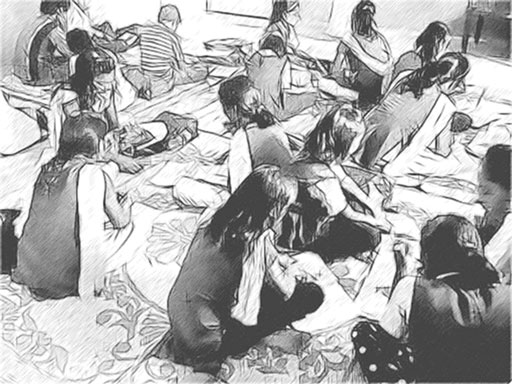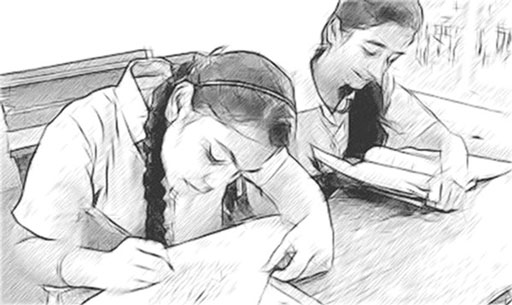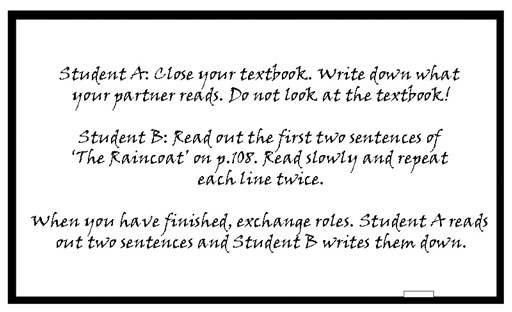1 Pair and groupwork speaking activities
Students may need to speak in English in all kinds of situations in their lives beyond school. In order to be fluent and confident, they need to practise. However, many students do not have enough opportunities to do this; the only place where they can practise speaking English is in their classes. This means that you need to create opportunities to speak in English for real purposes, so that students use the language to communicate with you and with each other.
You may be thinking that it is difficult to give all your students the opportunity to speak in class, especially if you have a large number of students. One way that you can give all of your students the chance to speak is by organising them into pairs or small groups (for example, of three or four students) to talk with each other (Figure 1).

There are many advantages of using pair and groupwork for learning:
- they allow students to learn from each other
- students at different levels can help and support each other
- they can be especially beneficial for practising speaking in English.
Pair and groupwork offer a safer environment for students to try out their speaking because fewer people hear them but all students have opportunities to speak and listen. This enables students to develop confidence in their speaking in English. You may want to have a look at key resources, ‘Using pair work’ and ‘Using groupwork’.
Pair dictation as a step towards communicating in English
Pair dictation is a simple way to get your students used to speaking and listening to each other in English. This activity is not purely communicative, because students are not creating meaningful sentences on their own. However, the students who are speaking get useful practice in pronunciation and the students who are listening and writing also practise spelling and punctuation. These skills help them to develop their confidence and their ability in communicating in English in real life.
Case Study 1: Ms Dutta uses pair dictation for her students to practise speaking English
Ms Dutta recently attended a training session about the importance of giving students the opportunity to speak English in class. At the session, she learned about using pair and groupwork.
I teach Class IX, and we are working through Chapter 8 of the NCERT textbook Beehive. In the last class we reached page 108, which has the following dictation activity:
‘The Raincoat’
After four years of drought in a small town in the north-east, the vicar gathered everyone together for a pilgrimage to the mountain, where they would pray together and ask for the rain to return.
The priest noticed a boy in the group wearing a raincoat.
‘Have you gone mad?’ he asked. ‘It hasn’t rained in this region for five years, the heat will kill you climbing the mountain.’
‘I have a cold, father. If we are going to ask God for rain, can you imagine the way back from the mountain? It’s going to be such a downpour that I need to be prepared.’
At that moment a great crash was heard in the sky and the first drops began to fall. A boy’s faith was enough to bring about a miracle that not even those most prepared truly believed in.
Normally, I read dictations from the textbook aloud, and students listen and write. However, in the training session I learned that the teacher does not always have to be the person who is speaking in class. I realised that my students could be the ones who give the dictation. I thought they could do this in pairs. One student would read out the text, and the other would listen and write it down.
I told my students to make pairs with the person next to them. There were some students left over at the end of some benches, who made groups of three instead of pairs. Then I told my students to begin dictating the passage to their partner(s). I moved around the classroom, and noticed that most of the students were having problems. They didn’t know what to do, and they were just reading the passage. I realised that my instructions hadn’t been clear. I told everyone to stop, and decided to try again.
This time, I told the groups, ‘Decide who is Student A and who is Student B’. (Groups of three had two students with the same letter.) I gave them one minute to decide. Then I said ‘Student As, raise your hands. Student Bs, raise your hands’. This way I knew that everyone was clear about who was Student A and who was Student B. Next, I gave the class instructions for the activity and wrote them on the blackboard.
I made sure that everyone understood the instructions by getting them to say what they needed to do in their home language. I told my students, ‘You have ten minutes for the pair dictation.’ The Student As began to dictate the passage to their partners [Figure 2]. As they did the activity, I walked around the classroom, listening to the pairs and checking that everyone was doing the activity correctly. Some of them were still not sure, so I explained again. Most of them were enjoying the activity and it was working well. It was good to hear so many of my students speaking in English.

As I listened, I heard that some of the students made mistakes with pronunciation. I didn’t interrupt them. I made a note of the most common pronunciation mistakes and decided that I could correct these mistakes with the whole class after the activity. I thought that my notes could be useful for assessment (see the unit Supporting language learning through formative assessment).
When nine minutes had passed, I told the students, ‘You have one more minute.’ When ten minutes had passed, some of the students had not quite finished reading, but I knew that everyone had had a chance to dictate some sentences. It was not possible for me to check all of their work, so I asked them to check and correct it themselves by comparing it to the passage in the textbook. This helped them to see where they had problems with spelling or punctuation.
The activity went well on the whole, although I realised that I need to give clearer instructions for these kinds of activities. I am going to use more pair work in my classes. I think that the more I use it, the more students will get used to it.
Activity 1: Using a pair dictation
You can use this activity with any short passage and with any class. Follow these steps to try a pair dictation exercise with your students:
- Before class, find a short passage (such as a paragraph) that your students could use for dictation. Make sure that the text isn’t too complicated in terms of vocabulary and punctuation.
- Organise your students into pairs (for example, with the person next to them). Check that everyone is in a pair. Anyone left over should join a pair to make groups of three.
- Give students instructions for the pair dictation, using English if you can. You could write the instructions on the blackboard. Check that they understand the instructions (for example, by asking students to say what they have to do in their home language).
- Make sure that students switch roles at some point, so that the one who was speaking now has to write and the one who was writing now has to speak.
- Give a time limit for the activity, such as ten minutes.
- Walk around the room as students work. Check that they understand what they are supposed to be doing and help where necessary or make notes (for example, of common pronunciation or spelling problems). Check that all students are involved in the activity.
- When the time is up, tell the students to stop working.
- Tell the students to check their work with the textbook.
- Provide feedback on any common mistakes (for example, with pronunciation, spelling or punctuation) that you noticed.
Pause for thought Here are some questions for you to think about after trying this activity. If possible, discuss these questions with a colleague.
|
Students need to understand what they need to do before they work in pairs or groups. Writing instructions on the blackboard is a good idea so that students can refer to them as they work. You could also demonstrate the activity with the whole class first, getting two students to practise the activity in front of the whole class.
If not all of your students spoke, try to find what the problems are. Are your students afraid of making mistakes? Do they find working in pairs uncomfortable? Students may find pair and groupwork difficult at first. It can help if you tell them about the benefits, and that it will get easier with practice. Use pair and groupwork as often as you can and students will soon get used to it. See Resource 1, ‘Involving all’, for more on involving all students.
What you can learn in this unit

